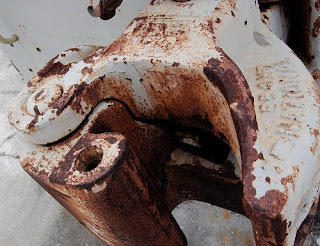After looking through his writings I got a very vivid picture of his art practice and how, rather than being studio practice, it is social practice where he allows himself the freedom to do work that is not so tied to the commercial art world. Some of the things that really stood out to me, and obviously did to him, was an undergraduate class he was in. The first day the class was told to pick an outdoor physical activity to do during class time for the rest of the semester. Harrel decided to walk on railroad tracks and became very good at it by the time they met together at the end of the semester. Of all the classes he took, he remembers this one better than all the lectures, exams, assignments, and discussions that were part of his other classes.
I was also impressed by what he said about teaching; "Most of what I do as an art professor now is based not my art education but instead on my farming education."Harrel spent some time doing a farm apprenticeship following graduate school which turned into a very important learning experience. I'm also reminded of something he mentions, which we also discussed in sculpture class last semester. The basic premise is that our education system is not set up for teaching as well as it could be. I find there to be solid logic behind this and agree with his philosophy in many ways.
Wednesday, February 2, 2011
Tuesday, January 18, 2011
Steel Brackets and Architectural Space

 For some reason or another, I am drawn to heavy duty, well built or even overbuilt construction. I think part of it may be that I get a sense of satisfaction out of something that's durable and made to last; also, I'm not interested in going at length through all the necessary calculations so as to minimize the amount of strength required. As a precaution and so as to reduce risk of failure, I aim toward the other extreme. There are times though when a project of mine does not have quite the durability that I had expected. In situations like that, the piece will exist in a more fragile state, but should function be an important factor, I seek out a way to reinforce the piece and make it stronger. I use this word loosely. When I talk about strength, I'm thinking of it in terms of implied in addition to the physical characteristics and ability to withstand force. When reinforcing the piece is not an option, I look for a way to protect the piece during storage and transport, as in a crate or space in which the object can reside.
For some reason or another, I am drawn to heavy duty, well built or even overbuilt construction. I think part of it may be that I get a sense of satisfaction out of something that's durable and made to last; also, I'm not interested in going at length through all the necessary calculations so as to minimize the amount of strength required. As a precaution and so as to reduce risk of failure, I aim toward the other extreme. There are times though when a project of mine does not have quite the durability that I had expected. In situations like that, the piece will exist in a more fragile state, but should function be an important factor, I seek out a way to reinforce the piece and make it stronger. I use this word loosely. When I talk about strength, I'm thinking of it in terms of implied in addition to the physical characteristics and ability to withstand force. When reinforcing the piece is not an option, I look for a way to protect the piece during storage and transport, as in a crate or space in which the object can reside.I'm thinking of these things in relation to my sculptures and also in terms of architectural space. In order to create an installation of my work, I'm considering how I might convert a traditional gallery space into an industrial setting, one set up like a warehouse/shipping yard. In that case, some of these industrial design elements can be infused in my work and in the units I create, sculptures in themselves, which replace the traditional white pedestal.



Wednesday, January 12, 2011
Tuesday, January 11, 2011
Subscribe to:
Posts (Atom)



















